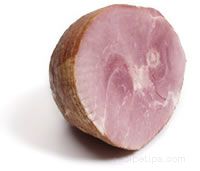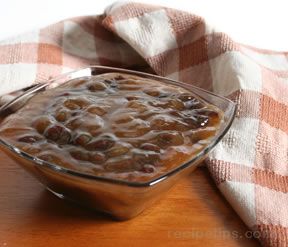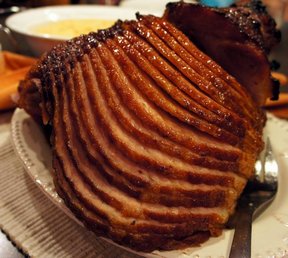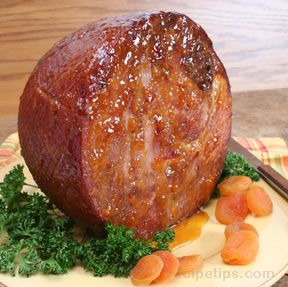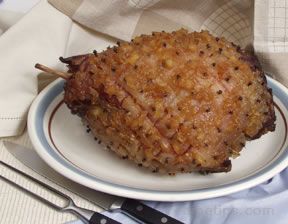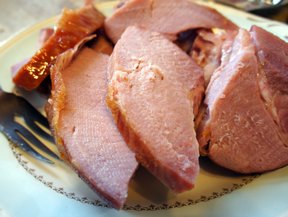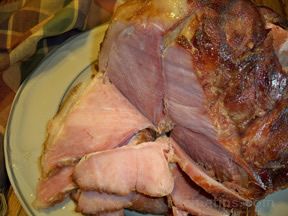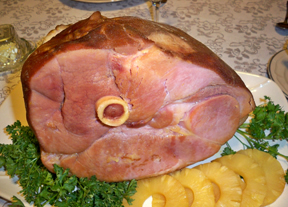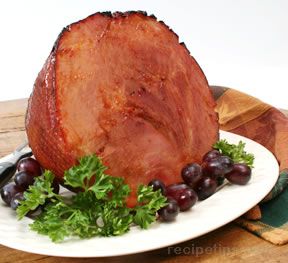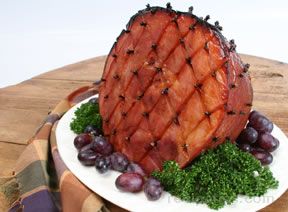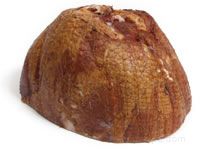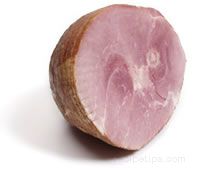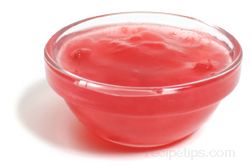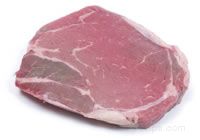Choose the Perfect Ham
Ham provides a practically effortless menu plan. Most hams are available pre-cooked and pre-glazed, allowing the host time to relax and visit.
The following terms are used to describe the ways in which Hams are processed and labeled. Refer to the tables when determining which ham style to purchase.
| Bone-in Ham | A butt, shank, or whole/half leg that has the hip, thigh and/or shank bone remaining | Provides 2 to 3 servings per pound |
| Bone-less Ham | Round, oblong or rectangle-shaped cut with all bones and most fat removed | Provides 4 to 5 servings per pound |
| Semi-boneless Ham | Leg primal cut that has only the leg bone remaining | Provides 3 to 4 servings per pound |
| Fully Cooked Ham | Ham that has been heated through to the middle reaching temperatures exceeding 147º F, ready to eat without further cooking. |
| Partially Cooked Ham | Ham that has been heated through to middle reaching temperatures exceeding 137º F, still requires additional cooking. |
| Uncooked Ham | Ham that requires cooking to prepare meat for eating. |
| Boiled Ham | Ham that has been boned, cured and cooked using a process that includes boiling the ham in water. It does not require cooking. |
Styles
| Whole Ham | Cut which includes both the butt ham and shank ham from the leg. Whole hams can weigh from 10 to 20 pounds or more. Available bone-in and boneless. |
| Butt Ham | Cut taken from the top half of the leg. It is fattier than the bottom half but contains more meat and is easy to carve around the bone. It is generally more expensive than the shank ham. |
| Shank Ham | Cut taken from the bottom half of the leg. It contains less fat, is not as meaty as the butt ham, and is also harder to carve. It has a slightly sweeter flavor. |
| Spiral Sliced Ham | A precooked ham that has been pre-sliced in a spiral cut for your convenience. A spiral cut is a cut that is done in one continuous cut around the ham, starting at one end, and moving consistently to the opposite end to create the same thickness of slices throughout. |
| Canned Ham | Ham that has been cured, bones removed, and vacuum sealed in can with a small amount of dry gelatin. The ham is steam cooked in the can and the gelatin helps to absorb the natural juices of the ham. Ready to eat, or it can be heated before serving. |
| Picnic Ham | Not a true ham but a cut from the shoulder of the pig. The cut is cured and smoked and is not as lean or tender but is less expensive. |
Jazz it up
If you purchase a ham that has not been pre-glazed, jazz it up! The following are some simple ideas, but you may want to improvise!
* Mix equal amounts (approx. 1/4 cup, depending on size of ham) of powdered mustard and brown sugar. Sprinkle mixture over ham surface for the final 30 minutes of cooking.
* Mix equal amounts (approx. 3/4 cup, depending on size of ham) orange juice, and pear juice. Baste ham twice within the first 15 minutes of baking.
* Mix equal amounts (approx. 3/4 cup, depending on size of ham) of brown sugar and honey. Brush sugar/honey mixture over ham during last 1/2 hour of baking.
* Mix 1 cup of raspberry preserve (or cherry, apricot, etc) with 1/2 cup of light corn syrup. Mix until well blended and brush on ham during last 15 to 30 minutes of baking.
Ham Baking Tips
Line your roasting pan with aluminum foil, it will make clean up easier.
Do not add water to roaster.
To avoid drying out ham, cook slowly at 325ºF. Allow 30 minutes per pound for ham that has not been precooked (follow directions on label for precooked hams).
Begin roasting ham by placing fat side up, the melting fat will baste your ham. Turn ham half way through baking to avoid uneven salting from the brine in the meat.
After ham has completed roasting, take ham out of oven and let stand 15 minutes before slicing. Ham will continue to bake when out of the oven and letting ham stand for 15 minutes makes it easier to carve.
Safety and Storage
Using a thermometer is the only safe way to tell if food has reached a temperature high enough to destroy harmful bacteria. Here are some guidelines to safeguard friends and family:
* Plastic wrapped ham will keep in refrigerator for about one week.
* Plastic wrapped and vacuum packed hams can be frozen up to 2 months. To preserve flavor/texture, wrap tightly in freezer paper.
* Fully cooked ham can be served cold or reheat to an internal temperature of 140º F.
* Ham that is not precooked must reach an internal temperature of at least 160º F.
Avoiding the bone, insert the thermometer into the thickest part of the meat. The bone conducts heat much faster, giving a false reading.
* Within 2 hours of the start of your meal, all perishable foods should be refrigerated. Eat leftover ham within 1 week.
Mimosa anyone?
Champagne adapts wonderfully to virtually any meal. Mimosa brings thoughts of spring and is a marvelous brunch cocktail. Choose a dry champagne, fill champagne flute with an equal amount of orange juice and champagne. If you would like to provide a non alcoholic alternative, replace champagne with lemon lime soda.
Ham is a particularly difficult food to match with wine, because of the saltiness of the ham and the variety of sweet glazes used in the preparation. For those of you that do not consider yourself a wine connoisseur, the table below will give you some direction in selecting a wine whether you prefer a red, white, or a rosé.
Ham
Red: Beaujolais, Zinfandel, Pinot Noir
White: Chenin Blanc, Riesling, Charonnay, Gewürztraminer, Riesling
Rosé: White Zinfandel, White Grenache
Ham (sweet/smoked)
Red: Beaujolais (lightly chilled)
White: Chenin Blanc, Gewürztraminer, Riesling
Rosé: White Zinfandel, White Grenache






